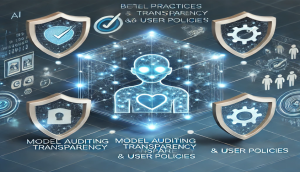Introduction
As AI technology becomes more widespread, so do concerns around data security. AI systems, especially those that power social media, smart devices, and even financial services, require vast amounts of data to function effectively. This reliance on data brings about privacy and ethical questions, especially when user data is involved. Addressing AI security isn’t just about defending against cyber threats; it’s also about setting ethical standards and ensuring user trust in a highly data-dependent world.

1. Data Privacy: An Urgent Concern
One of the pressing issues surrounding AI is how much user data is needed for training.
The challenge is twofold: users often remain unaware of how their data contributes to AI development, and tech companies have the ongoing responsibility to safeguard this information. For example, platforms like X (formerly Twitter) have come under scrutiny for using user posts and interactions for training AI without clear consent. Although users can adjust their privacy settings to opt out, the default setting often opts them in, leaving them largely unaware of these data practices. Transparent consent processes and informed user agreements are vital steps toward greater data privacy

2. Recognizing AI-Specific Security Threats
AI models can be susceptible to unique forms of cyber threats:
・Data Manipulation: By altering training data, attackers can influence how an AI behaves, a technique known as data poisoning.
・Privacy Invasion: Techniques like model inversion allow attackers to reverse-engineer models to extract private information about individuals in the training data.
・Deception through Adversarial Attacks: These attacks involve subtly modifying data input to mislead AI systems, which poses significant risks, particularly in high-stakes fields such as finance and autonomous driving.
By understanding these risks, developers and users alike can work towards more secure systems, prioritizing not only the accuracy of AI but also the integrity and safety of the data driving it

3. Navigating Regulatory and Ethical Frameworks
As technology outpaces regulation, various regions are introducing measures to protect data privacy. In the European Union, for instance, GDPR mandates explicit user consent for personal data usage, making it harder for companies to default to automatic data collection. In the U.S., California has implemented data privacy protections, though a comprehensive federal law remains absent. These regulations reflect a growing commitment to enforcing user rights, though challenges remain as technology continues to evolve

4. Best Practices for Strengthening AI Security
Given the unique vulnerabilities AI systems face, here are some best practices for securing AI models:
・Regular Model Audits: Routine model evaluations and monitoring can reveal vulnerabilities and detect suspicious activities, helping to prevent potential breaches.
・Explainable AI: Transparent models are easier to scrutinize and help identify bias or unfair treatment within the data.
・User-Centric Policies: Educating users about their data rights and providing clear options to opt-out can empower them to control their data footprint, thereby fostering trust.

5. Looking Forward: Privacy-Protecting AI Innovations
The future of AI security lies in developing privacy-preserving technologies such as federated learning, which enables machine learning models to train on user data without needing direct access to it. As AI’s role expands across sectors, proactive measures like these will be essential to ensure both data protection and model accuracy.
Conclusion
AI security calls for a balanced approach that safeguards user data, complies with evolving regulations, and respects user autonomy. In a world where AI is increasingly embedded in our daily lives, it’s crucial that developers, policymakers, and users work together to establish trust, uphold data integrity, and protect privacy.


